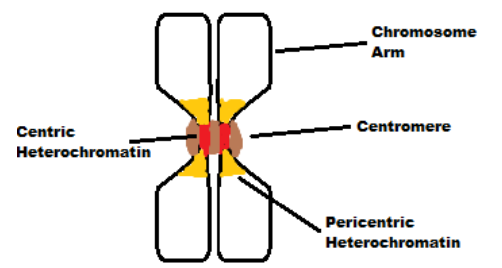
Differentiate between: Euchromatin and Heterochromatin.
Answer
581.4k+ views
Hint: The arrangement of the euchromatin can be represented as a widely spread set of beads in a thread where the beads constitute the nucleosomes. The nucleosomes consist of histone proteins that cover the DNA around. Heterochromatin typically packages the same sequences of DNA in all cells of the same species. It is regularly rhythmic and is present in structural forms like telomeres and centromeres.
Complete answer:
The following are the important difference between heterochromatin and euchromatin:

Note: Euchromatin is further lightly packed DNA that is exemplified by less extreme staining and DNA sequences that are transcriptionally dynamic or might become transcriptionally-active at some point throughout growth.
Heterochromatin is a firmly packed or condensed DNA that is identified by intense stains when stained with nuclear stains, holding transcriptionally dormant sequences. It exists in many variations, up to four to five states, each of which is marked with blends of epigenetic markers expressed.
Complete answer:
The following are the important difference between heterochromatin and euchromatin:
| HETEROCHROMATIN | EUCHROMATIN |
| The staining of heterochromatin might cause heteropycnosis; heteropycnosis is the differential staining of areas of chromosomes. | The staining of heterochromatin might not result in heteropycnosis; heteropycnosis is the differential staining of parts of chromosomes. |
| The two most regular heterochromatin include; constitutive heterochromatin and facultative heterochromatin. | Unlike heterochromatin, euchromatin doesn’t exist in two forms. It only exists as constitutive euchromatin. |
| Heterochromatin has numerous functions. Some of these include gene regulation and chromosomes’ reliability. | The transformation of euchromatin to heterochromatin acts as a method for regulating gene expression and replication. |
| The tightly packaged DNA in heterochromatin stops the chromosomes from various protein factors that might direct to the binding of DNA or the erroneous demolition of chromosomes by endonucleases. | Few genes like housekeeping genes are always arranged in chromatin conformation as they have to be incessantly replicated and transcribed. |

Note: Euchromatin is further lightly packed DNA that is exemplified by less extreme staining and DNA sequences that are transcriptionally dynamic or might become transcriptionally-active at some point throughout growth.
Heterochromatin is a firmly packed or condensed DNA that is identified by intense stains when stained with nuclear stains, holding transcriptionally dormant sequences. It exists in many variations, up to four to five states, each of which is marked with blends of epigenetic markers expressed.
Recently Updated Pages
A man running at a speed 5 ms is viewed in the side class 12 physics CBSE

State and explain Hardy Weinbergs Principle class 12 biology CBSE

Which of the following statements is wrong a Amnion class 12 biology CBSE

Two Planoconcave lenses 1 and 2 of glass of refractive class 12 physics CBSE

The compound 2 methyl 2 butene on reaction with NaIO4 class 12 chemistry CBSE

Bacterial cell wall is made up of A Cellulose B Hemicellulose class 12 biology CBSE

Trending doubts
What are the major means of transport Explain each class 12 social science CBSE

Which are the Top 10 Largest Countries of the World?

Draw a labelled sketch of the human eye class 12 physics CBSE

Explain sex determination in humans with line diag class 12 biology CBSE

Give 10 examples of unisexual and bisexual flowers

State the principle of an ac generator and explain class 12 physics CBSE




